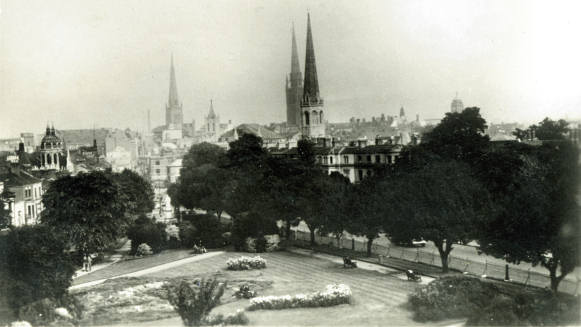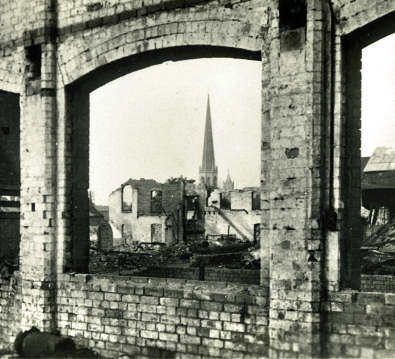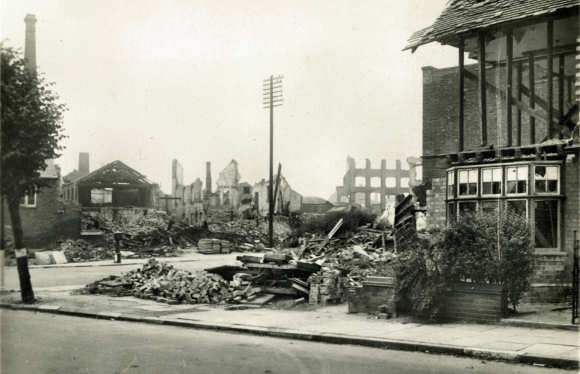|
Index...
|
 hile the November raid was obviously the single most shocking and devastating event in Coventry's war, it was by no means the only air-raid, and much destruction was caused by other attacks - particularly two heavy raids in April 1941.
hile the November raid was obviously the single most shocking and devastating event in Coventry's war, it was by no means the only air-raid, and much destruction was caused by other attacks - particularly two heavy raids in April 1941.

To previous generations of Coventrians, war had always been something remote - it only happened on a battlefield between armies. However, advances in technology had changed everything, and now war could be brought to a civilian population who had certainly not "signed up" to such a thing.

The first visible sign that the Germans were indeed bringing World War Two to Coventry was on the 25th June 1940, when they bombed Ansty Aerodrome on the outskirts of the city. On this occasion, only five bombs were dropped, and no casualties resulted. However, on the 27th June things were different. Hillfields, near the city centre, was bombed, and with sixteen deaths, the war was now very real.
Sunday the 25th August 1940 was the date for a considerably heavier raid, but fortunately, on this occasion no fatalities occurred, although half a dozen required hospital treatment. Much damage was done that night, however, including the destruction of the fairly new 'Super Cinema', The Rex, and a little more about that can be read on the 'Myths' page.
The first daylight raid occurred on the 26th September, but was a single bomber hitting the paint-shop of the Standard Motor Works at Canley. Several other single-aircraft daylight raids were to happen, and some pilots brought a truly vicious side to the war by machine-gunning civilians in the streets. The days of chivalry had gone, and this could only strengthen the British resolve to destroy the aggressors.
The first heavy raid involving a mixture of incendiaries and high explosives on the actual city centre was on 12th October, causing damage to a wide area. On the 14th they came again, this time destroying part of a peaceful gem of Coventry's past - Ford's Hospital.
After the big raid of November 14th, the number and intensity of raids on Coventry eased off somewhat, but suddenly, on the 8th April the following year, that was to change. That night the Germans flew overhead for six hours, dropping more bombs and incendiaries on an already depleted centre of Coventry. Two nights later they returned, spending three hours overhead. Between these two heavy attacks, approximately 360 tons of bombs were released, killing another 451 people, (which necessitated another mass funeral) putting the combined destruction on a scale approaching the eleven hour raid the previous November.

Christ Church was perhaps the most notable building destroyed during those April air-raids, although its loss was probably tempered; partly by the fact that the main building was not much more than one century old, but maybe more so because the spire survived, leaving Coventry with its full compliment of three!
For the weary citizens of Coventry, these two raids were, thankfully, to prove almost a final flourish, and as the direction of the war started to change, in future the Germans would only send over one or two planes at a time, causing no more than six fatalities in any one raid. On the 3rd August 1942, Stoke Heath was to be the last place in Coventry to be hit by any bombs, but the occasional warning siren was still to sound until the 3rd August 1944 - less than eight months from the end of World War Two.
Website by Rob Orland © 2002 to 2025